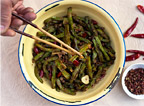Winter melon 冬瓜 (dōng guā)
A large gourd, about the size of a watermelon, with a dark green skin and white flesh, it has a light flavor similar to zucchini and is often sliced and added to soups and stir-fries. The outside of the melons can accumulate a white wax-like coating, which gives them their alternate name: wax gourd. They can be bought year-round at Asian grocery stores.









 Tuesday, January 11, 2011
Tuesday, January 11, 2011